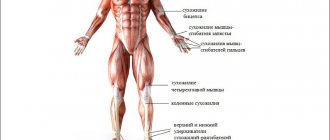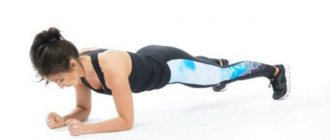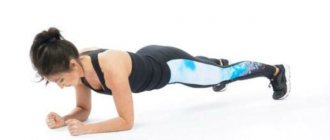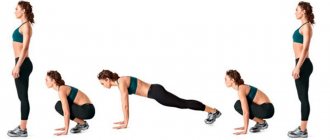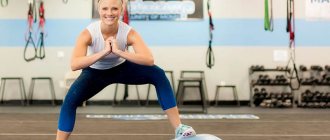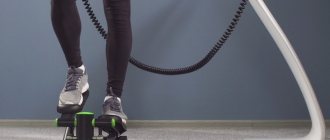Isometric exercises[edit | edit code]
The essence of isometric exercises
lies in the fact that within 6-12 seconds maximum effort is expended to counteract the resistance of a particular object. This is what distinguishes isometric exercises, in which muscle contraction only causes tension, from isotonic exercises, during which muscle contraction causes its length to change. One of the most popular isometric abdominal exercises is the plank.
Benefits[edit | edit code]
Firstly, this is a huge time saving. These exercises only take a few minutes to engage your muscles.
Secondly, in such a short time the muscles do not have time to get tired to the same extent as during a regular workout (lasting 1-2 hours), after which 24-36 hours are needed for the muscles to fully rest, and without sufficient rest, as has already been said many times, Neither muscle strength nor their mass increases.
Since the time required for rest decreases when performing isometric exercises, you can train much more often.
And finally, one of the biggest advantages of isometric exercises is that with their help it is very convenient to develop and strengthen exactly those muscles that especially need it at the moment.
When performing traditional isotonic-dynamic exercises, maximum muscle tension lasts only a few seconds, that is, in the sum of all exercises done (over 1-2 hours), no more than 2-6 minutes per workout. Isometric exercises can perform the same task in just a few minutes a day. Moreover, the increase in muscle strength in this case is not inferior to the increase in strength during isotonic exercises.
When performing isometric exercises, the blood vessels that supply oxygen to the muscles contract. The cells are forced to work more intensely and do not expend as much energy as during isotonic muscle movement (in which most of the energy is spent on the movement itself). Thus, all muscle energy when performing isometric exercises is spent only on tension, and not on movement. Therefore, muscle development occurs in a much shorter time.
Contraindications
In general, isometric exercises are less intense for major muscle groups than many dynamic movements. It is important to train carefully if you have injuries: they can get worse.
Consult your doctor before starting isometric exercises if you have high blood pressure or heart problems. Avoid holding your breath or straining during any strength training, as this can cause a dangerous increase in blood pressure.
Types of isometric exercises and methods of performing them[edit | edit code]
Based on the nature of execution, isometric exercises are divided into three groups:
- isometric-static exercises in their pure form, when maximum muscle tension counteracts resistance that cannot be overcome;
- exercises with weights, during which they stop for a few seconds (thereby creating isometric tension);
- exercises with the maximum possible weight, the initial phase of which has a clearly expressed isotonic-dynamic character, but the main phase is isometric-static, since already at a distance of 12-15 cm from the initial position of the bar an obstacle is installed that stops the movement.
With the help of such exercises, you can force the muscles to experience maximum tension in the most effective and necessary phase of movement at the moment.
Thanks to isometric exercises, you can most effectively increase the strength of muscles that are lagging behind in development, or muscle groups that are of paramount importance for an athlete for one reason or another.
To perform isometric exercises, a special simulator design was created, which is not difficult to make yourself. This is an iron frame (110-120 cm wide and 200-230 cm high), on both sides of which a metal pipe can be fixed.
But isometric exercises can be performed without special devices, using for them any solid object fixed in space, providing the muscles with such resistance that they, even being under maximum tension, are not able to overcome.
Basic isometric exercises
:
- bench press;
- craving;
- squat.
Success can be achieved by doing all these 3 exercises: one press exercise, one deadlift exercise, one squat exercise.
To this three you can add 2 other exercises:
- raising on toes;
- shoulder lifting.
More experienced and resilient bodybuilders can practice the “three deuces” system (when each of these exercises is performed 2 times), or the “three threes” system (when the exercises are performed 3 times) to achieve the best results.
There are several options for the position of the barbell when pressing:
- low position (at chin level);
- middle position (at eye level);
- top position (3-5 cm below the bar pressed to capacity).
When traction there are also three positions:
- low position (at knee level);
- middle position (at hip level);
- upper position (at waist level).
There are also three positions when squatting:
- low position (squat);
- middle position (half squat);
- upper position (squat with slightly bent legs).
If one exercise from each group is performed, the middle position is most often chosen as the most effective.
A series of isometric exercises of 5 exercises, each of which takes 12 seconds to complete (plus a minute break after each exercise), lasts a total of 6 minutes. This series can be repeated 2-3 times, maximum 6 times (changing the position periodically).
Depending on the duration, voltages can be:
- short (6 seconds);
- medium (9 seconds);
- long (12 seconds).
The intervals between exercises usually do not exceed 45-60 seconds, which is usually enough to restore normal breathing. The entire static isometric workout should not take more than 15-20 minutes.
When performing isometric exercises for the first time, care must be taken: initially, the tension should be limited to 6 seconds, given that it should not be maximum. After some time, you can move on to 9-12 seconds of maximum tension with breath holding.
Isometric exercises can be performed daily, as you don’t feel particularly tired after them. But at the same time, you should not abuse too much volume in an effort to achieve noticeable results as quickly as possible.
Despite all its advantages, isometric exercises cannot completely replace dynamic exercises, which allow developing certain abilities that cannot be achieved with isometric exercises alone.
Objectively approaching the assessment of isometric exercises, it is necessary to note a number of their weaknesses compared to dynamic ones: they do not supply the muscles with blood as intensively, contribute to muscle shortening, and do not develop coordination of movements and motor abilities of the muscles.
Static exercises, while increasing muscle strength, at the same time lead to the muscles losing the ability to move quickly. Dynamic exercises, due to the optimal ability to conduct excitation (innervation), are very effective in this regard.
With the simultaneous development of static and dynamic strength in an athlete, innervation does not deteriorate: muscle strength acquired through static exercises also manifests itself in speed strength. Moreover, the results of dynamic training are significantly improved.
Today, the optimal method for developing muscle strength is considered to be one that combines static exercises that develop strength with dynamic and relaxation exercises.
Bob Hoffman, in his book One Minute Every Day for Physical Endurance, Strength, and Health, suggests performing 12 isometric exercises without implements for 1-2 minutes.
The author offers a set of exercises that do not require any special equipment; as a counteracting object, he recommends using a wooden or metal door frame (door frame) or an ordinary wall, which is available in any room.
Here are the 12 exercises.
- In a standing position (without tilting your head back or bending your knees), press on the upper frame with the palms of your hands, which are slightly bent at the elbows.
- Crouching, apply pressure to the upper frame.
- Rise on your toes as high as possible and stay in this position for 6 seconds. Even though this exercise is only partially isometric, it is very effective.
- This exercise develops the neck muscles. To perform it, stand with your back to the wall, feet shoulder-width apart, hands on your belt. Press the back of your head against the wall, placing something soft under your head.
- This exercise is similar to the previous one, but you need to press on the wall not with the back of your head, but with your forehead.
- To develop arm muscles, perform the following exercise. Place your palms together and press with one hand on the other.
- This exercise is similar to exercise 6, but you need to connect your hands only with your fingers.
- Press with both hands on the vertical parts of the door frame.
- Press on the horizontal part of the door frame alternately with one hand and then with the other, slightly bent at the elbow.
- Press with both hands, elbows straight, on the vertical parts of the door frame.
- Pull the object attached to the door frame down.
- In a sitting position (bending your knees at different angles), apply pressure to the vertical parts of the frame with your feet.
The duration of each exercise should not be more than 4-6 seconds.
It is useful to combine this complex with a variety of movements that develop speed and flexibility (sports games, running and swimming). Many bodybuilders use them as supplements to their main workouts.
Often the new is the well-forgotten old. Many effective methods of physical improvement that were used earlier are today perceived as a new word in the development of sports. And this is not surprising. These techniques and equipment have stood the test of time. Moreover, the kettlebell occupies one of the first places in this series in terms of versatility of use.
Worth knowing:
Eccentric training causes muscle hypertrophy, while concentric training only maintains muscle strength but does not affect muscle growth. In one study, men were instructed to perform only the eccentric phase or only the concentric phase for 4-6 sets with a range of 8-12 repetitions, 3 times per week for 12 weeks.
It turned out that the number of slow-twitch fibers did not increase in either group, while the number of fast-twitch type II fibers increased 10-fold in the eccentric group compared to the concentric group.
Isometric exercises, Samson system[edit | edit code]
Samson's isometric exercises for forearms
Samson's speech
Isometric (static)
are those exercises in which the length of the working muscle does not change. Accordingly, there is no movement in the joint. Isometric exercises have been known for a long time, but we owe the creation of a system based on them to Alexander Ivanovich Zass, also known as Iron Samson, who, with the help of his system, achieved incredible strength, despite the fact that the athlete’s own weight did not exceed 80 kg. He believed that the basis of strength was the strength of the tendons, not the volume of the muscles. Isometric exercises are good because the workout takes no more than 15-20 minutes and does not require a lot of equipment.
In modern strength sports, isometric exercises are used to increase strength, to overcome dead spots, and to overcome stagnation in training. Below are Samson's basic exercises with a description of the muscles involved.
exercise 1
Chain in bent arms at chest level. Using muscle effort, try to stretch the chain. The exercise targets the latissimus dorsi, rear deltoids and triceps.
exercise 2
The chain is behind the head, at the level of the back of the head. Using your triceps, try to stretch the chain.
exercise 3
Chain on outstretched arms above the head. Try to stretch the chain. The exercise is aimed at increasing the strength of the latissimus dorsi muscles.
exercise 4
Chain behind my back. Try to stretch the chain by moving your arms forward. This exercise develops strength in the chest, triceps and deltoids.
Isometric training from Tamir Sheikh
exercise 5
As you exhale, wrap the chain around yourself. After inhaling, try to stretch the chain by tensing the pectoral and latissimus muscles.
exercise 6
Holding one end of the chain below with your left arm extended, try to stretch it with your bent right arm. Then we change hands. The exercise develops the strength of the biceps and triceps of the arms.
exercise 7
Standing with both feet in the middle of the chain and holding its ends with your hands, try to stretch the chain using the force of your trapezius.
exercise 8
Starting position, as in exercise 7, elbows pressed to the body, using the force of the biceps we try to stretch the chain.
other exercises
Having understood the basis of this method, you can come up with dozens of similar exercises yourself, aimed at developing the strength of any muscles of the human body.
General rules for performing isometric exercises[edit | edit code]
Exercises are performed while inhaling. The effort during the exercise is gradually increased to maximum. The exercise time is no more than 5-6 seconds for beginners to practice this method and no more than 10-12 seconds for experienced users, while the maximum effort lasts no more than 2-3 seconds. The total time of isometric training using this method is no more than 15 minutes. The number of approaches for each exercise is 2-3 approaches. When performing isometric exercises, blood pressure can greatly increase, so if you experience headaches, you should stop training immediately.
Isometric training according to the Samson method can be carried out not only with a chain, but also with a metal rod or wooden stick, a towel or a piece of thick rope, etc. Imagination has no limits. To avoid injury, you need to warm up thoroughly before training - injured tendons take much longer to heal than injured muscles, so you need to be especially careful when performing isometric exercises
This can be done in three ways:
- ask your training partner to resist the muscles in the eccentric phase. For example, when lowering a barbell, a partner presses against it, thereby preventing negative consequences and adding additional resistance.
- alternation of unilateral (eccentric) and bilateral (concentric) movements. For example, you can pull yourself up with two hands and lower yourself with one.
- (mini-bands, strength bands, tera-bands, etc.) during training When using bands, the muscles are constantly tense in both the concentric and eccentric phases. The band creates resistance that free weight cannot provide. To reduce the elasticity and strength of the band/band, you need to use twice as much muscle force as in the case of exercises with dumbbells or barbells. It's a good idea to add some resistance exercises to each workout.
Isometric training in public transport[edit | edit code]
You can do a workout even in a crowded vehicle and not look like an idiot in the eyes of others. You could say that people around you won’t even notice anything. This method was repeatedly successfully used by the author of this article during frequent trips to the subway. Here are some exercises that apply to this case. The starting position for all exercises is standing, holding the top rail with both hands.
exercise 1
Grab the handrail from above. Push the top handrail up with both hands. Triceps, deltoids, and chest work here.
exercise 2
Overhand grip. Pull the handrail down. The latissimus dorsi and biceps muscles work.
exercise 3
Overhand grip. We try to stretch the handrail to the sides. Triceps and lats work.
exercise 4
Overhand grip, shoulder width apart. We pull the handrail together with our hands towards each other. The chest, biceps, and deltoids work.
exercise 5
Underhand grip. Pull the handrail down. Similar to exercise No. 2, but here the load on the biceps is greater, and the serratus back muscles also work.
other exercises
Based on the above exercises, you can come up with many more when traveling on public transport. Just don’t forget the rules of isometric training outlined above. The author even successfully practiced isometric supersets while on the subway. For example, first you push the handrail up for a few seconds, and then immediately pull it down. With frequent use of this technique and a corresponding increase in strength, be careful not to break the handrail in the subway or trolleybus, otherwise you will have to compensate for material damage.
Isometric training at a lecture[edit | edit code]
Well, what else can a student do during a boring lecture, if not train his muscles unnoticed by others and, especially, by the teacher? The author, once a student, came up with several simple isometric exercises that allow you to usefully spend time on unloved lectures, such as Marxism-Leninism.
exercise 1
Grab the seat you are sitting on with both hands and, straining your trapezius and biceps, try to lift it up.
exercise 2
Hold the seat with both hands and try to push it down. If the body rises above the seat, then you can put your legs under the seat. Triceps, chest, deltoids work.
exercise 3
We put our hands under the desk and try to lift it. Designed mainly for biceps.
exercise 4
During lectures it is convenient to do several other types of exercises - isometric and dynamic self-resistance exercises, static muscle tension (Anokhin's volitional gymnastics) and some others. In this article, I will give an example of some isometric self-resistance exercises that are invisible to others. Hands are on the sides of the knees. With the force of our hands we try to bring our knees together, but with the force of our legs we do not allow this to happen. The muscles of the chest, arms, and abductor muscles of the legs work. When performing the exercise, do not forget to pretend that you are listening carefully to the teacher.
exercise 5
Hands are on your knees. We try to spread our knees to the sides, but with the force of our legs we do not allow this to happen. The adductor muscles of the legs, latissimus, trapezius, triceps, and posterior deltoids work.
exercise 6
With the palm of the half-bent left hand, we press down on the palm of the half-bent right hand. At the same time, the right hand presses upward, as a result, no movement occurs and we still smile sweetly at the teacher. Then the hands change roles. Works the biceps and triceps of both arms.
exercise 7
We bring our hands together with our palms facing each other at the level of our stomachs, so that it is not noticeable from the outside, and press them against each other. The muscles of the chest and arms work.
exercise 8
We clasp our palms together with our fingers and try to spread our arms to the sides. In this case, the trapezius, deltoids, triceps, and forearms work statically.
other exercises
I suggest you work with your own imagination, there is quite enough work for it.
What is isometric training?
During exercise, our muscles typically contract in three different ways (depending on the movement being performed). When lowering a weight (for example, when lowering a barbell while performing squats) or when “extending” with a load, an eccentric contraction of the muscles occurs. The opposite process: when lifting a weight, the muscles contract, reducing the distance between the joints - this is a concentric contraction.
But there is a third type of muscle contraction, when the muscles contract but do not change their length - isometric contraction. Unlike standard strength training, where the muscles perform sequential concentric and eccentric contractions, isometric loading is performed in a static position.
Examples of such exercises include pushing a stationary object, say a wall, or tensing a muscle without moving, such as a plank exercise, a wall squat, or holding the bottom position while performing an exercise, such as a squat. As a rule, isometric loading uses body weight (as you will see below), however, if your training allows, you can use additional weights.


